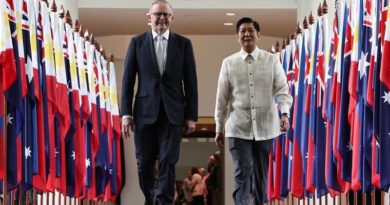HEADLINE | Laos can leverage regional position to boost growth: ADB
Laos has potential to leverage its regional position to boost trade.
.
.

Laos, a member of the Greater Mekong Subregion (GMS) Economic Cooperation Programme, can leverage its regional position to grow its economy and increase resilience to external shocks, according to a new Asian Development Bank (ADB) report.
.
“Leveraging Benefits of Regional Economic Integration” shows how Laos can leverage its regional position to boost trade, increase agricultural production, and harness the power of its cities to promote inclusive and equitable growth.
.
It details how improving competitiveness, community and connectivity can help converge the country’s income and living standards with other GMS member countries.
.
The report also discusses the potential for Laos to upgrade its value chain positioning, diversify its industries, and capitalise on regional cooperation to achieve its development targets.
“The Lao PDR is strategically located in the heart of the GMS. Along with the country’s neighbours, the subregion serves as a major trade partner with the rest of the world. This represents an opportunity to leverage benefits from regional cooperation to escalate development progress,” said Ms Sonomi Tanaka, the ADB Country Director for Laos.
.
“ADB has been a key partner in supporting development policy coordination in the subregion, including through defining a practical, goal-oriented work program for promoting regional cooperation.”
.
The regional position of Laos offers several opportunities.
.
The ADB study states Laos’s current trading basket indicates there may be unexploited potential for expanding into more diverse products which are traded with regional and global partners.
.
A potential pathway for further economic diversification is through developing shared production and export capabilities via greater regional cooperation.
.
The ADB report highlights the importance of upgrading and diversification through integration with value chains.
.
“Economic upgrading involves building on existing production capabilities while investing in new capabilities to accelerate the process of structural transformation.
.
Production capabilities are shared among products, and as comparative advantage is gained in new products, more opportunities to diversify become available,” the report states.
.
Currently, there are only a few sectors where Laos produces goods that have product complexity scores higher than the global average.
.
Most of these are associated with primary and low-tech industries.
.
Understanding these opportunities can help create short-run export diversification opportunities for driving the process of structural transformation.
.
Cross-border trade, connectivity and cities are pivotal for driving structural transformation and raising living standards.
.
For Laos, the link between urban expansion and economic growth has been weak.
.
Urbanisation has proceeded at pace, but the cities of Laos have remained relatively small, with most reported to have less than 300,000 inhabitants.
.
New roads have strengthened connectivity between cities and economic corridors, boosting potential for economic growth, according to ADB.
.
New policies must be put in place to unlock this potential and provide an enabling environment for new investments.
.
The private sector will have to invest in new capacities to produce more complex products and services, while cities need to become centres for sharing resources and fostering innovation.
.
Moving forward, strong public–private dialogue can be used to identify solutions for optimising the flow of goods and people towards realising the country’s vision of becoming a regional logistics hub.
.
By Times Reporters
(Latest Update December 13, 2022)


 Memento Maxima Digital Marketing
Memento Maxima Digital Marketing Ads by: Memento Maxima Digital Marketing
Ads by: Memento Maxima Digital Marketing






